
Haifa is the third-largest city in Israel—after Jerusalem and Tel Aviv—with a population of 290,306 in 2022. The city of Haifa forms part of the Haifa metropolitan area, the third-most populous metropolitan area in Israel. It is home to the Baháʼí Faith's Baháʼí World Centre, and is a UNESCO World Heritage Site and a destination for Baháʼí pilgrimage.
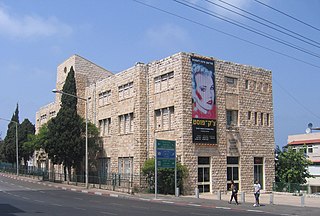
The Haifa Museum of Art, established in 1951, is located in a historic building built in the 1930s in Wadi Nisnas, downtown Haifa. Ranking as Israel's third largest art museum, the museum focuses on Israeli and international contemporary art, and its collection includes 7,000 items, mostly of contemporary Israeli art.
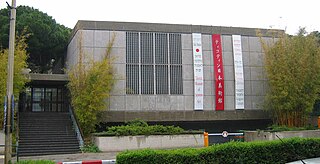
The Tikotin Museum of Japanese Art is a museum on the crest of Mount Carmel, in Haifa, Israel, dedicated to the preservation and exhibition of Japanese art. It is the only such museum in the Middle East. It was established in 1959 on the initiative of Felix Tikotin of the Netherlands, and Abba Hushi, who was the mayor of Haifa.

The Royal Museum for Central Africa (RMCA), communicating under the name AfricaMuseum since 2018, is an ethnography and natural history museum situated in Tervuren in Flemish Brabant, Belgium, just outside Brussels. It was originally built to showcase King Leopold II's Congo Free State in the International Exposition of 1897.

Hadar HaCarmel is a district of Haifa, Israel. Located on the northern slope of Mount Carmel between the upper and lower city overlooking the Port of Haifa and Haifa Bay, it was once the commercial center of Haifa.

Palestinian art is a term used to refer to artwork either originating from historic Palestine, as well as paintings, posters, installation art, costumes, and handcrafts produced by Palestinian artists in modern and contemporary times.

The Israel National Museum of Science, Technology, and Space is a science and technology museum in the city of Haifa, Israel. The museum has approximately 400,000 visitors annually.
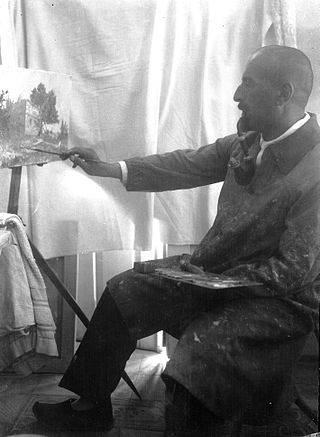
Alexander Baerwald was a German Jewish architect best known for his work in Haifa, today in Israel, during Late Ottoman and British rule.

The German Colony is an area of Haifa established in 1868 during Ottoman rule as a Christian German Templer Colony in Palestine. It was the first of several colonies established by the group in the Holy Land. Others were founded in Sarona near Jaffa, Galilee and Jerusalem. Some of the original buildings are still surviving today, and the area continues to be visited, lived in, and in use.
The architecture of Israel has been influenced by the different architectural styles of those who have inhabited the country over time, sometimes modified to suit the local climate and landscape. Byzantine churches, Crusader castles, Islamic madrasas, Templer houses, Arab arches and minarets, Russian Orthodox onion domes, International Style modernist buildings, sculptural concrete Brutalist architecture, and glass-sided skyscrapers all are part of the architecture of Israel.

The Museum of Byzantine Culture is a museum in Thessaloniki, Central Macedonia, Greece, which opened in 1994.

The Musée d'Art et d'Histoire du Judaïsme is the largest French museum of Jewish art and history. It is located in the Hôtel de Saint-Aignan in the Marais district in Paris.

The Baháʼí World Centre is the name given to the spiritual and administrative centre of the Baháʼí Faith, representing sites in or near the cities of Acre and Haifa, Israel.
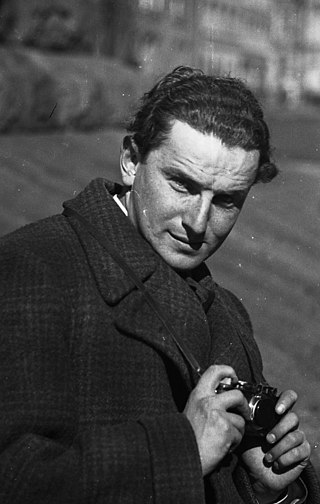
Ze'ev (Wilhelm) Aleksandrowicz was an Israeli photographer. He is mostly known for his work in Palestine and Japan, during the first half of the 1930s.

The Negev Museum of Art is an art museum in the Old City of Be'er Sheva, Israel. The building is the former Governor's Mansion, built in 1906 by the Ottomans as part of government edifices that include the Seraya and the local mosque.

Daphna Greenstein is an Israeli architect and landscape architect. Greenstein professioned in various design and planning aspects: landscape architecture, environmental design, and architecture. She specialized in designing a wide range of projects in the public realm.
The following is a timeline of the history of the city of Haifa, Israel.
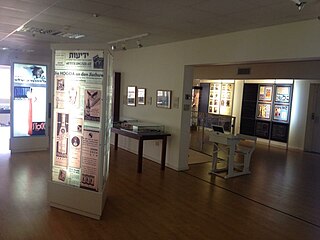
The German-Speaking Jewry Heritage Museum is a museum in Tefen, an industrial park in the north of Israel established by Stef Wertheimer.

Archaeological and historical finds, as well as contemporary works of art are displayed in the museums and exhibitions at Mount Olympus.
Hanna Farah-Kufer Bir'im or Hanna Fuad Farah, is a Palestinian visual artist, builder, and architect. He lives in Tel Aviv-Yafo, and in the village of Bir'im.

















